International experience07.05.2022
Analysis of innovation activity in the field of green economy in the Republic of Kazakhstan

Saule Bishimbayeva, Head of Competence Center for Commercialization of technologies, International Green Technologies and Investment Center, Phd in economics
According to the 2020 rating of the Yale Center for Environmental Policy and Law in the USA, Kazakhstan ranks 85th out of 180 countries on the environmental efficiency index. Compared to 2016 (69th place) Kazakhstan has reduced its environmental efficiency by 16 positions.
At the same time, Kazakhstan ranks 115th in terms of air quality, and the level of air pollution is increasing every year, especially in megacities and cities where 57.4% of the country’s population lives.
Kazakhstan’s lagging environmental efficiency is a consequence of various factors, including the poor introduction of environmentally friendly technologies to solve the problems of climate change and the environment.
CURRENT SITUATION
To date, the innovative potential of Kazakhstan is3,444 "green" patents for inventions and utility models, of which more than 50 are international (8 - PCT, 41 - EAPO).
According to the RSE NIIP, over the past seven years there has been a sharp increase in patent activity in the field of environmentally friendly technologies. Thus, in 2020 alone, 435 new "green" patents were registered, of which 52% - environmental, 48% - energy.
This is explained by the fact that since 2015, Kazakhstan has been operating an accelerated examination of renewable energy inventions (6 months), introduced shortly before preparation to Expo-2017.
Nevertheless, there is a paradoxical situation in Kazakhstan when patent activity in the field of "green" technologies is growing from year to year, and the number of enterprises implementing environmental innovations is decreasing from year to year.
Moreover, the analysis of 2,554 large industrial polluting enterprises of the Republic of Kazakhstan, conducted by the NJSC "International Green Technologies and Investment Projects Center" (hereinafter referred to as the Center) in 2019, revealed that only 141 enterprises use green technologies, i.e. 1.6% of the country’s enterprises.
This is despite the fact that, according to the National Bureau of Statistics of the ASPR of the Republic of Kazakhstan, investments for "green" economy increased 4.5 times compared to 2016and reached record values in 2019-2020 in the entire history of investments in this area (see Diagram 2). However, in general, investments in the "green" economy account for an insignificant share - only 1.6% of the country’s investments. Thus, according to the "green" economy concept (2013), in order to achieve the indicators of the Paris Agreement, it is necessary to invest 1% of GDP annually.
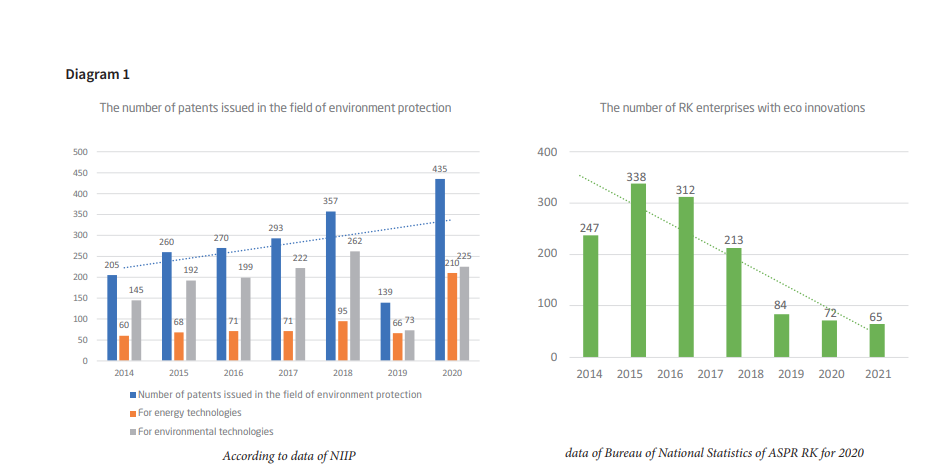
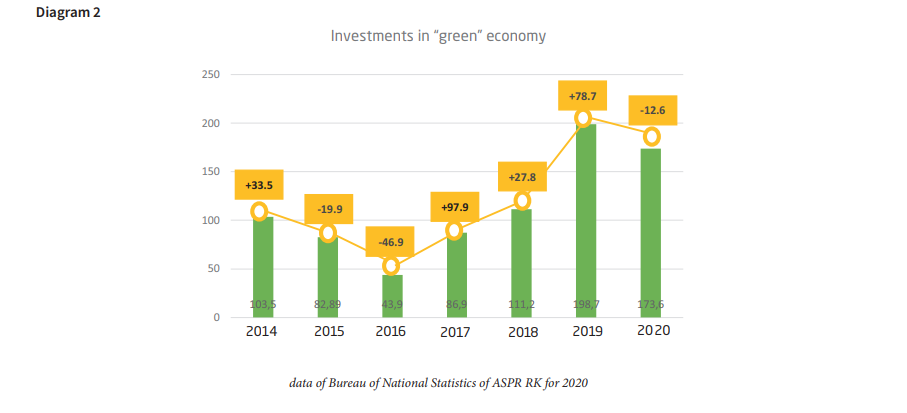
Analysis of statistical data for2020 revealed similar trends:
- the share of environmentally friendly products in the total output of the country is only 0.2%;
- extremely low level of innovative activity of enterprises for the introduction of environmental innovations - 0.3%;
- the costs of enterprises for environmental innovations account for 1.3% of the costs of enterprises for innovation;
- low share of "green" jobs - 1.6% of jobs in the country. The poor implementation of "green" technologies in
Kazakhstan is explained by such serious barriers as lack of technological competencies in the industry; enterprises are unwilling to provide information on emissions; poor interdepartmental communication and cooperation; "imperfect" legislation; insufficient economic incentive measures; lack of financial resources; lack of infrastructure to support commercialization.
In addition, an analysis of the database of about 300 "green" projects collected by the Center showed that over 70% of project relate to projects at an early stage of readiness for implementation. At the same time, most of the technologies are in the field of waste management, climate-optimized agriculture, energy efficiency and RES.
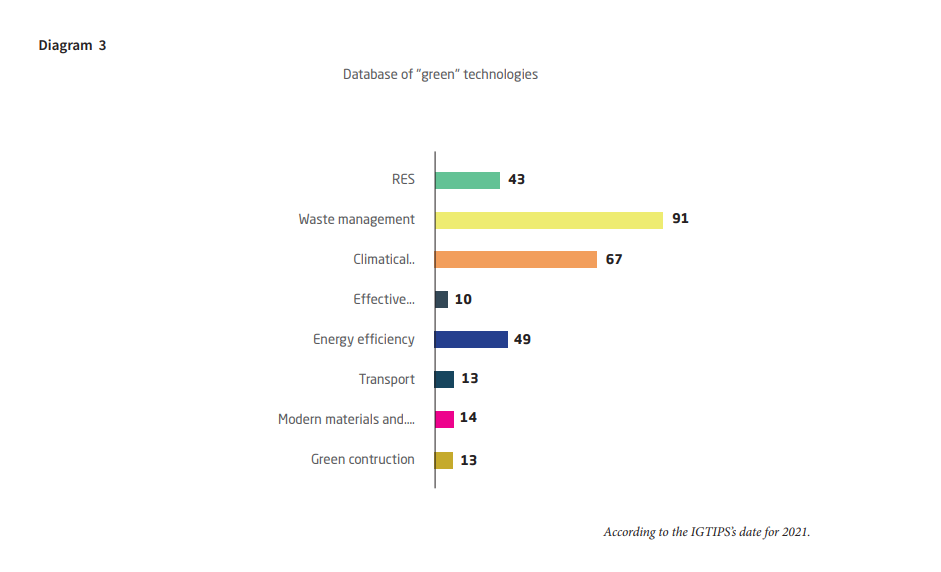
The low pace of innovation is also explained by the fact that companies in the field of "green" technologies differ from typical companies in that business is most often built on physical components. (Batteries, cars, solar panels, sensors, micro-grid components, etc.), therefore, unlike IT-companies for example, "green companies" have a longer "valley of death". It takes years for "green"companies to get stronger, a higher level of financial support, as well as the availability of a variety of skills and abilities to achieve success.
Moreover, the creation of waste-free ("green") industries, and all environmental protection activities always face resistance from industrialists, since they require large costs. Thus, the environmental costs of a coal-fired power plant, on average, account for a third of the cost of the power plant itself.
Therefore, an important article of the Environmental Code entered into force on July 1,2021, is the "Introduction of the best available techniques" (hereinafter referred to as BAT), aimed at modernizing industrial enterprises and conducting a comprehensive technological audit of 82 industrial enterprises of the 1st category. The Technical Handbooks are planned to be issued in 2023, and enterprises that have implemented BAT for 10 years are exempt from emission fees. At the same time, at the first stage, the top-50 enterprises that release 80% of emissions into the environment will switch to the principles of BAT.
However, when industrial enterprises begin to introduce environmentally friendly technologies, the question will arise where to get these best available technologies? Will they be available to industrial enterprises in the near future?
After all, many enterprises are already ready to modernize their production facilities before 2023. In addition, there are many other environmental problems in the country: the problem of industrial waste disposal (more than 300 million tons of solid waste); the problem of solid waste disposal (more than 120 million tons of solid waste), the problem of transport pollution, etc. At the same time, 57% of national GHG emissions are emitted uncontrollably and continue to grow, and the most environmentally vulnerable regions are Pavlodar, Karaganda, East Kazakhstan, South Kazakhstan, Aktobe and Atyrau regions (Diagram 4).
Therefore, it is necessary to develop simultaneously a technological platform of "green" technologies to identify, prepare and ensure a high-quality flow of the best available "green" technologies and projects for their further introduction into industrial production.
Thus, the above analysis indicates deterioration of the environmental situation in Kazakhstan due to the poor introduction of innovations, and the accelerated transfer of "green" technologies at the business level and especially small and medium-sized enterprises is still a bottleneck in the national innovation system of Kazakhstan.
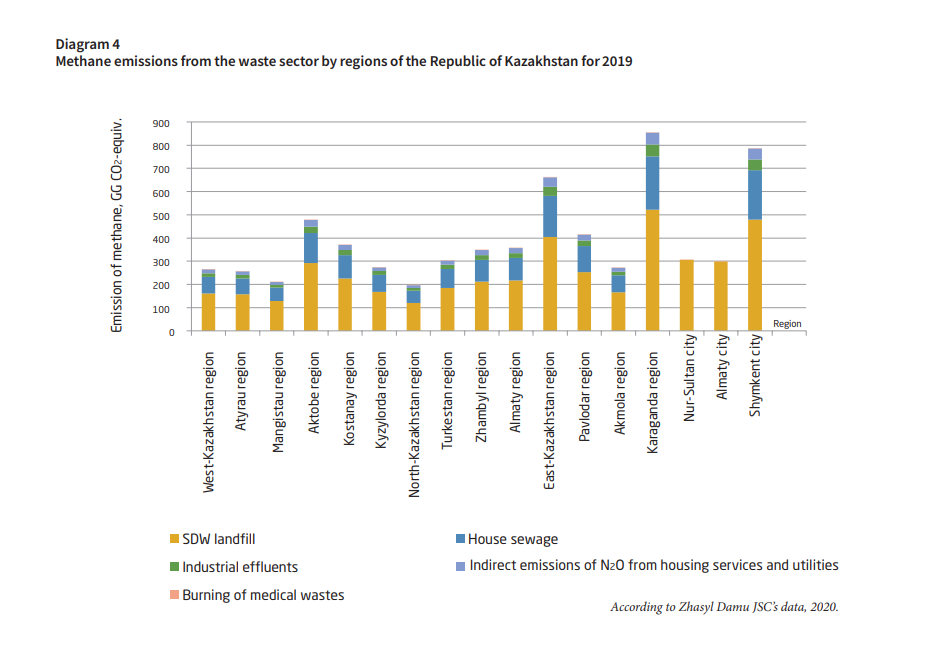
It is necessary to create immediately a mechanism for the rapid exchange of efficient and economical "green" technologies that would maintain balance and environmental safety and restore the environment. In this regard, let us turn to the best practices of developed countries.
WORLD EXPERIENCE
Currently, one of the key megatrends in the world is the growth of environmental requirements for enterprises, and eco-oriented enterprises are becoming a brand of modern responsible business.
Environmental requirements form new directions in industries: recycling, extraction of associated energy, the transition of larger number of enterprises to a full production cycle, i.e. a circular economy, including the economy of recycling.
The second equally important megatrend is the rapidly developing startup ecosystem of clean technologies and the growth of investments in low-carbon development.
Thus, according to UNIDO, the global clean technology industry will exceed $6.4trillion in the next decade. Of these, more than $1.7 trillion is available for SMEs and startups in developing countries. This is an opportunity for SMEs and startups to become key growth engines in the clean technology sector in these countries.
Thus, over the past ten years, global oil and gas industry corporations with the help of corporate venture funds have gained access to technologies and new business models developed by startups. At the same time, more and more emphasis is placed on environmentally friendly technologies, rather than on IT applications in the field of exploration and production. Thus, in 2019, 67% of the investment activity of oil companies is allocated for financing startups developing environmentally friendly energy technologies (Diagram 5).
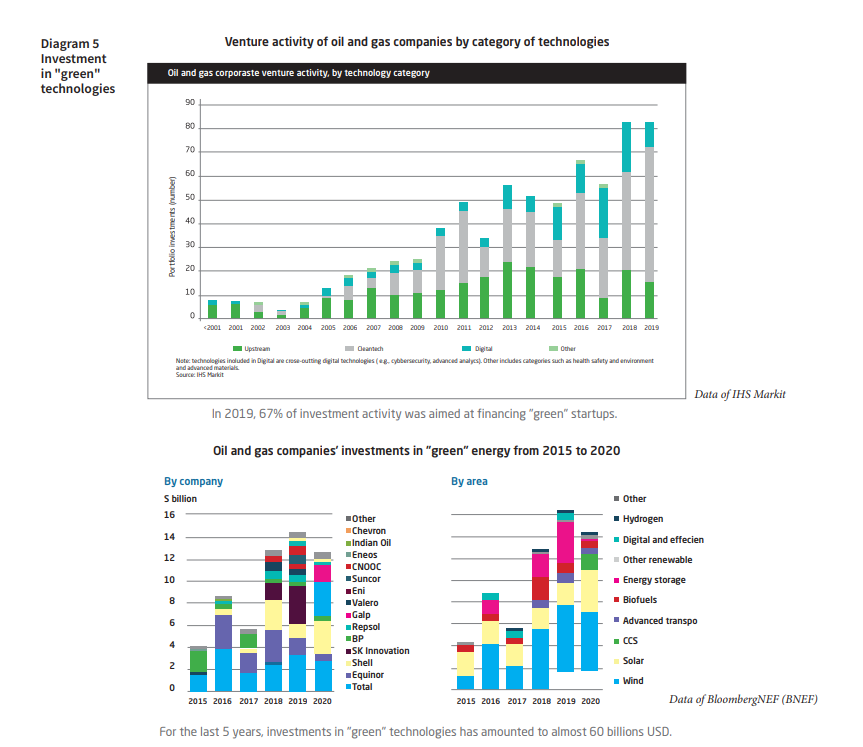
In 2015-2020, the total investments of oil and gas companies in renewable energy, energy storage, advanced transport, hydrogen, CCS amounted to almost $60 billion. The leaders of investments in clean technologies are such companies as Total, Shell, Repsol, Golp, SK innovation, BP, Eni.
Kazakhstan is an oil country where 46% of the economy is provided by oil production, so this investing experience of oil and gas companies in clean technologies is very relevant to attract additional investments in the "green" economy.
In developed countries, clean/"green" technologies are one of the main priorities of innovation development. Thus, the US long-term strategy for the development of innovations is mainly devoted to innovations in the field of environmentally friendly technologies and their practical use in order to increase the share of electricity produced in an environmentally friendly way to 80% by 2035 and reduce greenhouse gas emissions produced by coal-fired power plants. At the same time, in the United States, the focus is on innovations in the field of overcoming the consequences of global climate change, renewable energy sources, clean energy projects, hydrogen fuel, biofuels, the development of car batteries, solar panels, etc.
For systemic development, in 2012, the United States created the Agency for Advanced Projects in the field of clean energy (APRA-E), which establishes a link between scientific research, development and industrial implementation of new environmentally friendly technologies. This is an innovative PPP, a model with government officials communicating directly with venture financiers and entrepreneurs, engaged in technology development. It is an integrated system that uses the unique capabilities of scientific organizations, investors and the expertise of professionals working in the field of energy and clean technologies.
At the same time, the cluster approach is the most effective model for organizing technological platforms of clean/"green" technologies based on innovative PPP, which allows increasing economic activity due to close cooperation of all subjects of the industry.
The key to the successful development of clusters of "green" technologies is a favorable startup environment that attracts venture investors, funds from business angels, as well as crowdfunding. Thus, only in the California alone, which ranks first in the world in terms of venture financing of high- tech clean tech companies, an extensive network of more than 20 clean technology business incubators has been created.
An example of a successful urban cluster and innovative PPP partnership is Los Angeles Cleantech Incubator (LACI), which was created at record time as a result of a partnership between the Los Angeles City Hall and private investors and recognized by UBI Global as the most innovative business incubator in the world: https://laincubator.org.
Having prototyping and Training Centers, over 6years LACI has supported 220 companies (more than 50 of them international), attracted $465 million of investments (an average of $2.2 million per company), issued 119 patents, created 2,100jobs in the field of clean technologies, earned $270 million, and more than $470 million of long-term economic benefits for Los Angeles.
In 2050, LACI plans, together with regional stakeholders and other partners, to increase the number of "green jobs" by 80% from 320 000 (2021) to 600 000 in 2050.
The experience of Austria is unique, where a hundred years ago in Graz (Styria) the best (first of all, in terms of concentration of enterprises, growth dynamics, innovations) in Europe innovative cluster of "green" technologies - Cluster Greentech was created. This is a whole Valley of "green" technologies, where the largest number of the world’s leading companies in the field of environmentally friendly technologies are concentrated: https://www.greentech.at/en.
Today, 200 "green" companies and scientific organizations in Austria work on the territory of the Greentech Cluster and cooperate with 20,000 different partners around the world. Thanks to the creation of a favorable ecosystem of "green" technologies, the Styria region today occupies an honorable second place among300 regions of Europe, and companies are world leaders in the field of energy and environmental technologies.
In addition, the Russian Skolkovo Foundation has created a cluster of environmentally friendly technologies with the first accelerator of technological startups in the field of ecology in Russia - Green tech startup booster, launched with the support of the Ministry of Natural Resources and Ecology of the Russian Federation: https://greentech.sk.ru.
Thus, international experience clearly shows that the pace of mastering new knowledge in the field of ecology and environmental protection can be accelerated significantly with the help of a set of actively coordinated measures in the field of commercialization of environmentally friendly technologies, stimulated and supported at the level of public policy.
By analogy with successful countries, Kazakhstan needs to expand the window of opportunities and make a leap to solve the problem of "greening" the economy through the development of innovations, support for the commercialization system and accelerated introduction of "green" technologies.
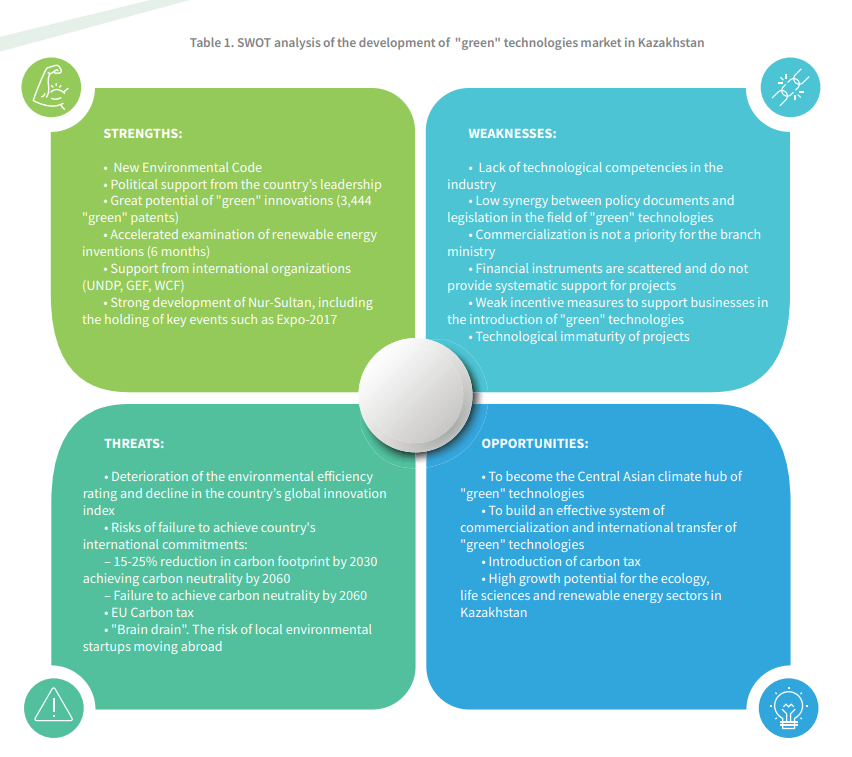
Trump signs executive order to end subsidies for wind and solar energy
Uzbekistan's solar and wind power plants generate 5 Billion kWh since beginning of the year
Green Corridor Alliance JV registered in Baku to promote green energy development in Central Asia and the South Caucasus
In the EU renewable energy supply grew by 3.4% in 2024
IRENA accepting renewable energy project proposals in Central Asia until August 15
Astana to host Electronica Expo Kazakhstan Electronics Exhibition
WB gives rundown of Azerbaijan's green energy grid volume prospects
US solar sets new records as renewables nearly match natural gas – EIA
‘Wings’ on poles: Bill Gates-backed breakthrough wind turbine facility breaks ground
Perovskite tandem solar cell achieves new efficiency record
Kazakhstan and China endorse draft SCO joint statement on sustainable energy development
Innovative research on organic solar cells for space applications
Kazakhstan and Uzbekistan drive green energy progress in Central Asia
KazMunayGas launches pilot green hydrogen project in Atyrau
How private homeowners in Kazakhstan can make money from solar panels
14 countries are investing in Kazakhstan's renewable energy sector through auctions
How green hydrogen could transform Kazakhstan’s energy sector
IKEA offers ready-to-use solar power systems for balconies
Adani commissions India’s first off-grid green hydrogen pilot plant
Tajikistan unveils green energy roadmap at international conference in Dushanbe











